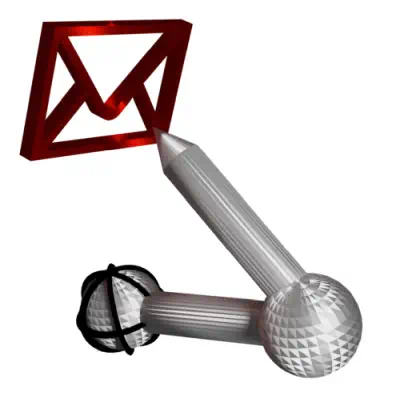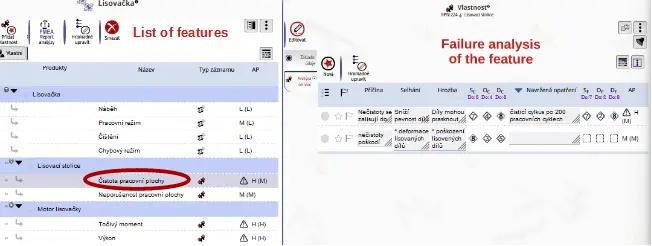AyMINE – Technical documentation
Modules
Integration with ERP Abra Gen
 Task, project & quality management
Task, project & quality management
Manager approval with the task report
Why some data can't be deleted
GDPR and record of qualifications
Qualification of user or contact
Right to Manage Qualifications
Adminitration of areas, projects, calendars
Failure Analysis for an Individual Property of a Component or Process
FMEA – Probability of Detection
FMEA – Probability of Occurrence
 Task, project & quality management
Task, project & quality management
Administration of the Task Management Module
System rights for the task management module
Improvements and Preventive Measures
Methodology and Quality Management systems
What makes up the methodology / SMJ
Problems, tickets and their management
Collaborative Resolution of Multiple Problems
Customer Service Response Generation
Incident and Quality Issue Management
Objects affected by the problem
Problems, Incidents, Helpdesk Tickets
Return project plan by baseline
Sample tasks and methodologies of the area
Effect of the task on the right to modify the attached object
The person responsible for the task
Working procedure – task definition
Management of responsibilities - RACI Matrix
Objects related to the task pattern
 Contacts and directories module (CRM)
Contacts and directories module (CRM)
Address book list and management
Directory or people and companies
Order overview for customer groups
 Contacts and directories module (CRM)
Contacts and directories module (CRM)
System Permissions and CRM Module Settings
Send bulk messages in compliance with GDPR
How to correctly forget a person's details
Unsubscribe and set preferences
for bulk mail
 Web management and automation
Web management and automation
Receiving a message from the web
Human resources
Personalistics – User Permissions and roles
Human Resources module security
Manage department / division data
Overview of Personnel Information for pracov# Employment Contract
Synchronizing staff and system users
 Products, assets and sales
Products, assets and sales
Creating and processing orders
Manage the Property & Business module
Why are the Quality criteria usefull
Managing Finance
Metrics and Measurements
Work summaries from generated data
Technical Modules
Sabre plugin module
Enterprise Architect connector
Database link to Enterprise Architect database
Enterprise Architect connector
System Modules
 The AyMINE Framework Module
The AyMINE Framework Module
AyMINE — Tips for Mobile Usage
Configure how your system looks and works
Gestures and Keyboard Shortcuts
More about how the system works
Private notes and tags for objects
Overview of Modules and Record Types
 Product FMEA Analysis
Product FMEA Analysis 
FMEA is used to identify potential issues with the functionality of a product through a detailed analysis of all its components and properties
- FMEA – Detailed Analysis
- Risk Identification
- Definition of Risk Reduction Measures
- Step 3: FMEA Report
- Don't forget
- RPN vs AP – Understanding FMEA Evaluation
Complete description of FMEA is available on a separate page here. This page focuses on the specifics of product FMEA.
Description of the FMEA process
FMEA – Detailed Analysis
FMEA allows the analysis of each individual component of the product based on its structure, examining its properties, functions, and operational modes. Based on these, the FMEA itself is carried out. – Functions, modes, and properties are key inputs for further analysis.
In line with the methodology, AyMINE supports the following within the FMEA analysis:
- Analysis of individual parts and individual properties (structural analysis)
- Functionality analysis (dynamic analysis)
- Description of operational modes.
For each element, threats, risks that may arise, and proposed measures are analyzed.
Functions
Functions describe what the product does and how it behaves. A typical function description includes input/trigger, data processing, and output.
For FMEA, the important questions are:
- What inputs is the function not prepared for (for example, deviation of input values due to overheating)
- How is it ensured that if the function fails, it will not endanger the product or its surroundings (including the user)
- How does the product recover if the function fails
All potential problems should be documented during the analysis.
Operational Modes
For each product, all operational modes must be described, including those that may last for a very short time. Typical operational modes include:
- Off (whether with no power supply or in standby mode)
- Disconnected (actually turned off inputs, for example, due to a failure in the surroundings)
- Diagnostic for current startup
- Normal operation
- Operation in restricted mode
- Operation in emergency (safety) mode
- Shutdown
- ...
Modes must be recorded, ideally with a state map or at least a description for each, explaining the circumstances under which the system enters each state. (States can also be directly linked in the system to a state map – this makes sense only if the links are actually used for analysis).
During the analysis, it is important to evaluate:
- What product functions are available in a given mode,
- What system requirements may arise, and whether the product can handle them in each specific mode. If not, what other consequences may it have
- What resources (e.g., power consumption) are needed in that mode and what happens if they are unavailable or stop being available
Properties
Properties include any other features of the product that are important for functional and safety analysis. Typical properties include:
- Emissions (e.g., electromagnetic radiation, vibrations, noise, heat)
- Changes in size/volume
- Durability concerning external conditions (important properties often include lifetime considering temperature, humidity, etc.)

Risk Identification
For each individual function, operational mode, and property, FMEA describes the risks that may arise if a failure occurs, and these risks need to be assessed. The system provides support for defining key parameters for each property (the references describe in more detail the significance of the rating scale):
- Probability that the situation will occur
- Ability to detect the problem in time
- Severity of the threat’s impact on people around, especially their safety
Each of these values must be defined separately for each parameter – the system automatically pre-fills the values and calculates how "risky" each property is in the product – the so-called rating. This provides a complete overview of what needs to be addressed – to reduce risk.
Definition of Risk Reduction Measures
For risks whose overall rating exceeds the threshold set for the product, measures to reduce them must be defined. The system allows you to define two basic types of measures:
- Requirement for the developed product
- Safety measures related to the product’s production (and associated controls)
Both types of measures are created directly from the identified property. It is important to create them from the property or link the property with the requirement/procedure to retain the information on how the risk was actually reduced – this way, you can later demonstrate what measures were taken and analyze whether they are appropriate. Conversely, for requirements and procedures, it will be clear why they are necessary.
Step 3: FMEA Report
Once the analysis is complete, the entire FMEA is generated into a report using the FMEA function. The analysis creates a report directly in AyMINE in HTML format – you can then add additional information before exporting it to PDF if needed. This allows you to easily add customer-required information.
Although the generated FMEA analysis is editable, it should not be used for the analysis itself – you would lose alignment with the product documentation.
Don't forget
FMEA Documentation Matters
Thorough FMEA documentation is an essential part of development. You need FMEA analysis not only when designing the product but throughout its entire lifecycle:
- When a problem arises that you need to address, for example, with an 8D report, so FMEA is an essential foundation.
- When developing a new version of the product, you only need to perform a differential FMEA analysis. Most of the work will be saved, but only if you can prove that you know the original FMEA and – importantly – you understand its conclusions and how they were reflected in the product design.
- You will, of course, need it for audits.
- If it ever needs to be resolved whether you’ve done everything necessary for the product's reliability, quality FMEA is a key piece of evidence for a responsible approach.
Special Characters of Product Properties
FMEA documentation should cover the important properties of the product, including their impact on safety or cybersecurity of the product itself. For each product property, you can define your own type and characteristics according to the needs of your analysis. Additionally, you can use a set of attributes shared with requirements and procedures. If you use them, they will automatically transfer to the requirements and procedures created based on FMEA – ensuring nothing is lost (as required by standards like ISO 26262, ISO 62061, and others).
RPN vs AP – Understanding FMEA Evaluation
The 2019 standard (FMEA Handbook) advocates using the Action Priority index instead of RPN (Risk Priority Number). Its calculation is different, and so is the output. While RPN is calculated as the product of severity (S), occurrence (O), and detection (D), AP is recalculated from the same values using a table. AP’s calculation is similar to ASIL assessment according to ISO 26262.
The FMEA Handbook explains the reason for the change:
RPN is not an adequate tool for determining what to focus on, as it gives equal weight to all three dimensions (S, O, D). This can give equal weight to two risks with very different S × O products, and the team then doesn't know which to prioritize. The threshold set on the RPN value is insufficient.
In comparison, the fundamental difference between AP and RPN is:
- If both S and O are very high, the priority rating will be the highest regardless of D.
- If at least one of S or O is very high, the AP will be at least medium-level.
In practice, AP evaluation rules reduce the importance of detection ability in the overall rating.
We believe the reasoning isn't entirely correct, but that's secondary. The practical impact is that AyMINE supports both RPN and AP because:
- According to AP, you need to choose what to focus on, as the current FMEA methodology requires this prioritization method.
- RPN, in our opinion, provides more accurate comparisons – instead of 3 AP values, it gives 1000 product values, plus it allows the calculation of sum and other statistical analyses, which makes it easier to compare individual components against each other. Based on these comparisons, it's easier to decide what to focus on globally.